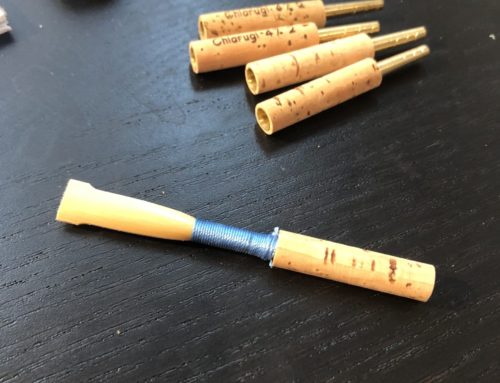Are all “crows” equal?
I decided to try an experiment. I used one batch of cane, the same staples, same gouging machine, pre-gouger, same shaper tip, and even the same thread. All six of these reeds were made on the same day, by the same person, using the same equipment.
My personal observations have been the same even when I have changed instruments and instrument makers over the years. So for the sake of this experiment we are removing the notion that my instrument is a factor. A future addition to this will most likely be using my other instruments by different makers to see how the results may vary.
Here are the specifications:
Cane: Glotin, 10-10.5
Staple: Chiarugi 47 2+
Pregouger: Jeanne
Gouger: Graf
Shaper tip: Adam Caleb
So what does it matter what pitch the crow is?
Nearly all of our literature says your reed should crow a set of 3 C octaves, for example Jay Light The Oboe Reed Book, David Weber and Ferald B Capps The Reed Maker’s Manual, Martin Schuring Oboe Art & Method. But why? While this is not an exhaustive list of literature on the subject of reed making, I think you get the idea. I choose these three books due to their wealth of knowledge and delivery. These three books are absolute staples to any oboe player, or teacher, starting the reed making process and much more.
My interest comes solely in how different authors have approached the crow in reed making, how they treat the crow throughout the process, and what they believe to be an ideal crow pitch.
David Weber uses the crow’s pitch in Chapter 10 of The Reed Maker’s Manual to indicate the qualities of the reed throughout his entire description of the scraping process. Weber reinforces the desire for three octaves of C for the reed to be balanced and fully functional.
Martin Schuring states that, “Some players are comfortable with a crow slightly lower or higher than C. These individual preferences, developed over years of experimentation and practice, so the student should start from the standard, which is C.” (Schuring 144)
Jay Light does often mention in The Oboe Reed Book that the crow can be somewhere between a B and a C but then ultimately states, “The goal of every reed with the best combination of response, pitch, stability, dynamic range and tone quality can most consistently be met by making a reed that will crow ‘C’ in three octaves simultaneously.” (Light 80). He then goes on to explain that in his personal experience, “The only reason I’ve ever found for compromising in the three ‘Cs’ in the crow is if you’ve been cursed with a badly designed oboe which wants to play very sharp, or with an instrument that leaks profusely.” (Light 80 footnote)
My experience
I have spent my reed making life, until several years ago, believing this to be true. The oboe reed needs to crow a C in order to play in tune and with a desirable tone quality. Though over the years I have had a number of reeds that I thought felt played great but the crow would be off, a B, B-flat, and even A. So I always assumed that something I was doing unconsciously was compensating for this low crow.
So I decided to take on the challenge and try this experiment to see what happens when I do not let the pitch of the crow dictate my scraping decisions but rather the back pressure produced while crowing the reed. When I finished my experimentation batch I got four very different results for the crow in six reeds. The process I went through is described below.
The experiment
Day 1
-Split tube cane
-Cut to length
-Pre-gouge
-Gouge
-Fold
-Shape
-Tie on
-Initial scrape to get the reed vibrating and clipped up to pitch
Day 2
-Finish scraping, ensure intonation is accurate and response/resistance are comfortable
-Break in with 20 minutes of playing
Day 3
-Adjust
-Final testing
Requirements to be put through to final results: The reed needs to be in tune, A=440, good response and resistance to blow against, and have a focused, clear tone.
Results: (Videos and more pictures coming shortly demonstrating the reed, crow and playing.)
Crow experiment pic with all 6
Reed 1: Crow is A.
Reed 2: Crow is B-flat.
Reed 3: Crow is B.
Reed 4: Crow is C.
Reed 5: Crow is B.
Reed 6: Crow is B.
This is by no means a comprehensive experiment, taking into account all factors. This is the beginning of intentionally gathering information based on different crows when “all things” else are the same, as described above.
This is a working experiment. I will be adding to this as I continue to work. I am open to comments, suggestions, and additions from other people’s reed experiments.
